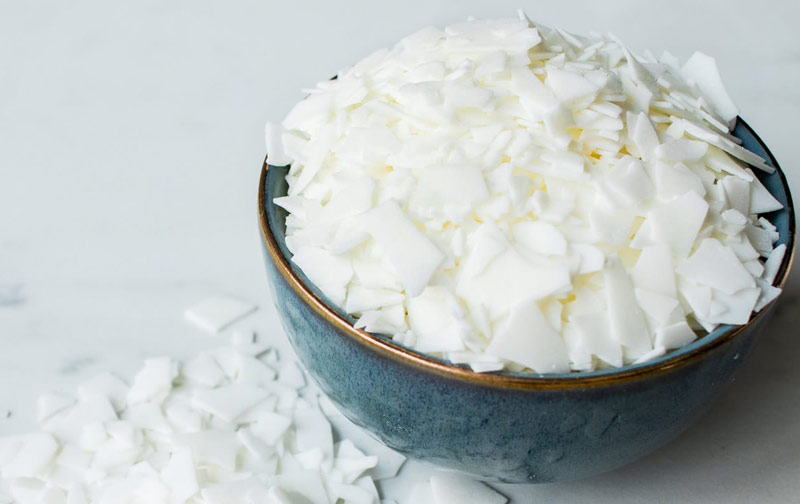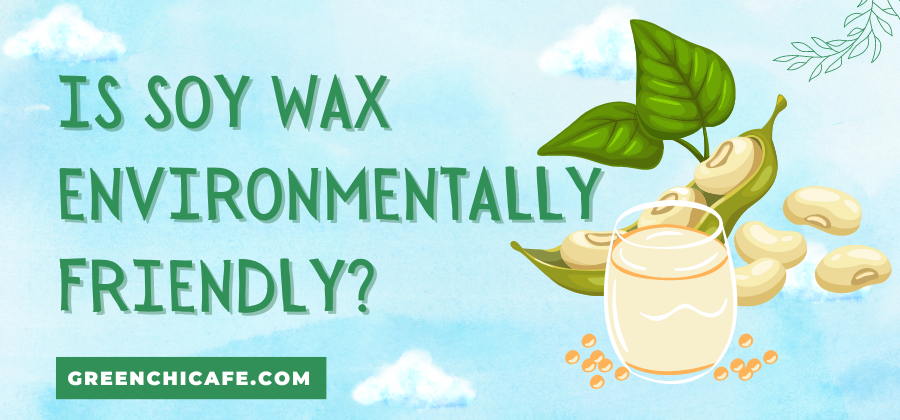Last Updated on June 3, 2024 by Annie Baldwin
Ever wondered what’s behind the gentle glow of your favorite soy wax candle?
Soy wax, celebrated for its eco-friendly reputation, has become a popular choice among environmentally conscious consumers.
In this article, we’ll dig into the sustainability of soy wax, examining its production, benefits, and potential environmental impacts, so you can make an informed decision about lighting up your space responsibly.
Is Soy Wax Environmentally Friendly?

Yes, soy wax is an environmentally friendly candle wax option.
It is made from soybeans which are a renewable, sustainable crop.
Soy wax is also biodegradable and non-toxic, unlike paraffin wax which is a petroleum byproduct.
Soy candles burn clean without releasing harmful toxins into the air.
Key Points
- Soy wax is made from soybeans, a renewable and sustainable crop.
- Soy wax is biodegradable and non-toxic, unlike paraffin wax.
- Soy candles burn clean without releasing harmful toxins into the air.
Our Opinion
Based on the research, we believe soy wax is the most environmentally friendly option for candle making.
Its sustainability benefits over paraffin wax are clear – soy wax comes from a renewable source, is biodegradable, and does not release toxins when burned.
Soy wax is a great choice for eco-conscious candle makers and consumers.
Is Soy Wax Sustainable?

When it comes to candle making, soy wax is often touted as the more eco-friendly option compared to paraffin wax. But is using soy wax better for the environment? Let’s take a closer look.
First, soy wax is made from soybeans, which are a renewable resource. Soybeans can be replanted season after season, making soy a sustainable crop. Paraffin wax, on the other hand, comes from petroleum, which is a non-renewable resource.
Additionally, soy wax is 100% biodegradable. It will break down naturally over time without harming the environment. Paraffin wax, being a petroleum by-product, does not biodegrade easily.
When burned, soy candles do not release any toxic chemicals into the air. Paraffin candles release some toxins like benzene and toluene when lit. This makes soy wax candles better for indoor air quality.
Finally, producing soy wax has a smaller carbon footprint than paraffin wax. Growing soybeans absorbs CO2 from the atmosphere, while drilling and refining petroleum releases greenhouse gases.
So with its renewable source material, biodegradability, non-toxic emissions, and smaller carbon footprint, soy wax can rightly be considered a more eco-friendly and sustainable option than paraffin wax.
Does Soy Wax Harm Bees?
Some people wonder if producing soybean crops for soy wax harms bee populations. Let’s look at the facts.
Soybeans do not require insect pollination to produce beans. The soybean plants are self-pollinating, so they do not rely on bees or other insects for pollination.
While soybean plants do not need bees, having bees and other pollinators around soybean fields can increase crop yields. The insects help pollinate other weed flowers in and around the soy fields. This keeps the plant ecosystem healthy and productive.
Studies show that soybean fields often have a similar abundance of native bee species as uncultivated land areas. Pesticide use does need to be minimized though to protect pollinator health.
So soy wax, when sourced from responsibly grown soybeans, does not inherently harm bees. Bees do not play a direct role in soybean production, and thoughtfully managed soybean farms can provide a habitat for bees and other beneficial insects.
Soy wax can be a better choice than paraffin wax, for bees and the planet. Just be sure to choose soy wax made from organically grown, pesticide-free soybeans. This helps protect pollinators and the environment.
How Does Soy Wax Compare to Paraffin Wax?
When choosing between soy wax and paraffin wax, there are a few key differences to consider.
Soy wax is made from soybeans, a renewable and biodegradable resource. Paraffin wax is made from petroleum, a non-renewable resource.
Producing soy wax has less environmental impact than drilling for and refining crude oil into paraffin wax. The soybean plants absorb CO2 as they grow, helping reduce greenhouse gases.
Soy wax is also free from toxins and is non-toxic if ingested. Paraffin wax releases toxins as it burns and can release carcinogens.
On the other hand, paraffin wax is generally cheaper than soy wax at this time. And paraffin offers a higher melting point, making it easy to work with.
For candle making and other uses, soy wax blends well with other natural waxes. This allows adjusting the melting point as needed. Soy also helps candles burn longer and prevents soot.
Ultimately, soy wax is the more eco-friendly and sustainable option over paraffin. But the choice depends on your specific needs and project budget.
Is Soy Wax Biodegradable?

Yes, soy wax is biodegradable. This makes it an environmentally friendly option compared to petroleum-based waxes.
Soy wax is made from soybean oil. When produced responsibly and sustainably, soybean plants absorb CO2 as they grow. The wax itself breaks down through natural processes when composted or disposed of properly.
Paraffin wax, on the other hand, is made from non-renewable crude oil. It does not biodegrade easily and persists in the environment. Paraffin can also release toxins as it burns.
Beeswax is another popular natural wax. However, some raise concerns over harvesting practices and sustainability. Soy wax provides a renewable and biodegradable alternative.
When shopping for soy wax, look for products made from organically grown and processed soybeans. This ensures the wax is produced in an eco-friendly manner from start to finish.
Soy wax is not only biodegradable but also non-toxic. This makes it safe for applications like candles, cosmetics, and food packaging. Its sustainability and low environmental impact make soy wax a great choice for crafters and consumers alike.
Are There Downsides to Using Soy Wax?
While soy wax offers many benefits, there are a few potential drawbacks to consider as well.
One is that soy wax generally has a lower melting point compared to paraffin wax. This can mean candles and other items may burn faster or lose their shape in warm environments.
Some additives can increase soy wax’s melting point. But these may also make the wax less environmentally friendly. Finding the right balance is key.
Soy wax is also softer than paraffin. Items like candles or cosmetics may not retain their shape as well over time. Extra care is needed when handling soy wax products.
Using hydrogenated soybean oil instead of pure soybean oil can address the low melting point and softness. But hydrogenation requires chemical processing which reduces the eco-friendly appeal.
Finally, some people may have soy allergies. Those with soy sensitivities may need to avoid soy-based products entirely.
With some adjustments to formulas and proper handling, the disadvantages of soy wax can be minimized. Many makers feel the benefits still outweigh the downsides for most applications.
FAQ
Which Wax Is Most Environmentally Friendly?
Soy wax is considered the most environmentally friendly candle wax option. It is made from soybeans, a renewable and sustainable crop. Soy wax is also biodegradable and non-toxic.
Are Soy Candles Safe for the Environment?
Yes, soy candles are safe for the environment. Soy wax is made from soybeans, a renewable resource. It does not contain harmful chemicals or toxins. When burned, soy candles release very little soot and smoke compared to paraffin candles.
What Are the Downsides of Soy Wax?
The main downside of soy wax is that it is softer than paraffin wax. This can make it harder to work with when making candles. Soy wax also has a lower melting point, so soy candles may burn faster than paraffin candles. Some people dislike the natural scent of soy wax.
What Is the Best Eco-Friendly Wax for Candle Making?
Soy wax is considered the best and most eco-friendly option for candle making. It is renewable, biodegradable, and non-toxic. Beeswax is another good eco-friendly choice but is more expensive than soy wax. Other options include palm wax and coconut wax.
Conclusion
In conclusion, soy wax is considered an environmentally friendly option for candle making. Soy wax comes from a renewable source – soybeans – and is biodegradable. Soy candles do not release harmful toxins into the air when burned like paraffin candles. Overall, soy wax has many sustainability benefits over traditional petroleum-based waxes.
